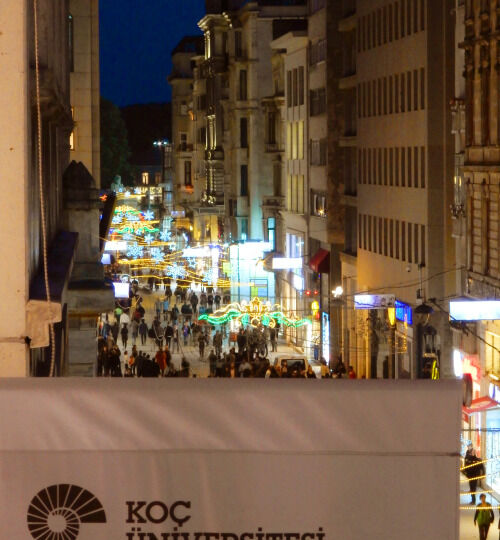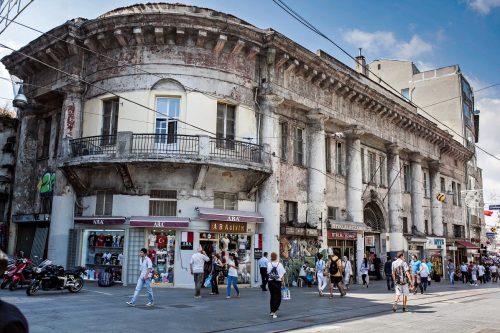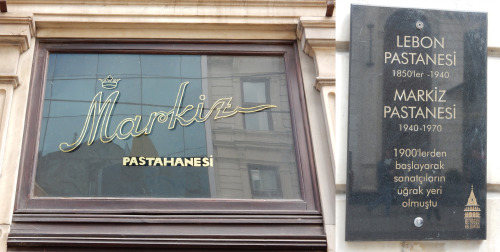
ANAMED Fellow B. Nilgün Öz compares earlier days of the ‘weekend-only’ trips to the bustling Istiklal Avenue and living next to it now as a fellow…
At this year’s ANAMED Fellows’ Symposium, I presented a paper about a rural community in the village of Çaltılar in Fethiye, and talked about how they viewed and associated with certain places in the landscape. I spoke of the meanings some places had for them, and how they weaved them into the history of the village itself as landmarks of a “collective mental geography” of Çaltılar. The research I have been conducting here at ANAMED not only allowed to me delve deeper into this topic, but also made me question my own relationship with the places I have been living in – which, since September last year, means Istiklal Avenue.
I have to admit, if someone had told me, say two years ago, that I was going to be living here, I believe I would have given them one of my now-famous (!) ‘blizzard’ looks: “What do you mean by living on Istiklal?” For me, and many others, Istiklal is never a ‘residential’ area. Having gone to high school in Istanbul, but in the much calmer district of Bakırköy, coming to Istiklal always meant ‘a weekend out with classmates.’ Especially during the last two years of school, when all of us were busy working for our university entry exams, going to Istiklal would signal one of our more adventurous weekends. I don’t know how my friends felt, but looking back on those times now, I realize that to me it was not the Istiklal part that was important: it was the journey itself. Meeting in the Bakırköy Meydanı (Square), waiting for latecomers, taking the bus (or sometimes taking the train), changing in Mecidiyeköy – a journey, which sometimes, if memory serves me right, would take about two hours. We would be talking non-stop and often times get criticized for being ‘so loud!’ Once in Taksim Square, we would walk straight to Istiklal, and by then everyone would be hungry, so we would go to Borsa Lokantası (Restaurant), followed by our invariable visit to the handicraft shop of the vocational high school. We would occasionally watch a film (one such experience resulted in us watching the last third of “Robin Hood: Men in Tights” before the middle part, but that’s another story) or stroll the various shops. Then it would be time for the trip home!
These ‘weekend-only’ Istiklal trips continued even after I moved to Ankara, having entered the Middle East Technical University: I would still frequent Istanbul and see my friends, and Istiklal remained a place to go together. As my visits to the city became fewer and fewer, however, the Istiklal I remembered slowly ceased to exist. I would read about the drastic changes going on, concerning the construction of the Demirören Shopping Mall, the demolition of Emek Sineması in the Cercle D’Orient (soon to be opened as Grand Pera), the eviction of the famous Inci Pastanesi (Patisserie) with its delicious ‘profiterols,’ and all the protests that accompanied these, and witnessed the changes personally on my occasional visits. Some of those places now gone, the demise of which also attracted national media attention, include the Markiz Pastanesi with its mouth-watering lemonade (now an eatery); Narmanlı Han, opposite the Swedish consulate – my favourite building on Istiklal – which is now boarded to hide new interventions; and the Kelebek Korse Dükkanı, a charming old shop, which was shut as it was unable to pay the extortionary rent.

It was not only the physical environment that was changing, the number of people visiting Istiklal was increasing exponentially. I remember perfectly well the day my husband and I traveled from Izmir two years ago and ended up arriving on Istiklal around 7 pm on a lovely September evening. For a moment I was dumbstruck: the entire street was an ocean of people, as far as the eye could see! How could one street take so many people?!
Now, I can see other sides to Istiklal, however limited they may be. Funnily enough, two of the most precious items I have had to buy since coming to ANAMED are 3M orange ear-plugs that help drown out the noise at night. Hearing the birds singing early in the mornings after such nights may sound like a miracle, but it is true. Living on Istiklal has become a sensory concoction of the ‘routine’: the church bells, reminding us of the time every day at 8 am and then at 7 pm, and other hours during the day, the reasons of which escape me; the call for prayer of the mosque; and the repetitive and mind-numbing calls of the national lottery ticket vendor “Bu akşam! Bu akşam!” (This evening! This evening!), alternating with “Yarın akşam! Yarın akşam!” (Tomorrow evening! Tomorrow evening!); cigarette smoke and baked potato smells filling my room depending on what time I choose to open my window; watching the periodically displayed balloon decorations of shops, deliberately hung to suggest a ‘new-opening’ so as to attract new customers; or trying not to get run over by a car if I am out early; and trying to wiggle my way through a wave of people and pretending it’s the most normal thing on earth to be walking up Istiklal armed with grocery bags, which may include a huge pack of toilet rolls! Wishful thinking it would be to try to escape the weekend tram-band that turns Istiklal into a festival ground on most weekends. After days out with friends on excursions to other parts of Istanbul, the moment you turn right from the Şişhane metro station, the difference of Istiklal literally hits you in the face: the street is oozing with energy and will most certainly let you know it!

Sometimes, living on Istiklal means discovering the small side streets in a wish to escape the hustle and bustle of the street. Sometimes it means coming to halt in front of a shop that had been open “only the day before, but where did it go?”, and to discover just a few days later that another shop has opened in the same spot. If the shops don’t change, it is the interiors that do. Galatasaray Football Club’s shop, for example, changed its interior only a month after its grand opening, which had been celebrated with the aforementioned tram-band!
Istiklal is ever-changing, and with it, our memories are in danger of losing their physical links with the cityscape, but nevertheless, this pulsating street always manages to capture imaginations with places now gone and those that we newly discover. Since September 2015, Istiklal means something else to me: it no longer is a ‘fun weekend with friends.’ It means ANAMED, which – if I were to make my personal ‘memory map’, or maybe a ‘meaning map’ of the places in Istiklal, where the radius of circles denotes the scale of importance I associate with a place – would no doubt get the largest circle.

